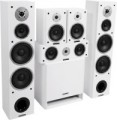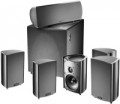Mount
—
Outdoor. As the name implies, these speakers are designed for installation on the floor and have a corresponding design: for example, in most models, the cabinet has a large height, selected in such a way that the speakers are at the optimum height when placed on the floor. In addition, floor acoustics are designed with the calculation of the influence of the floor itself on the sound; this allows you to achieve evenness and good depth of low frequencies. Floorstanding speakers in general have the highest power among all types and are usually designed for large rooms.
—
Shelf. Shelf speakers are relatively small in size and are designed to be placed on shelves or stands of a different kind, at a significant elevation from the floor (the optimal height is considered to approximately correspond to the location of the listener's head). The advantage of this placement is smooth sound at all frequencies. In addition, such models usually have less power than floor standing ones and are well suited for small spaces — besides, the shelves can be mounted on the wall like a
wall speaker.
—
Floor / shelf. This type includes multi-channel (see "Intended use") systems in which one part of the speakers is designed for floor installation, the other for shelf installation. The former usually include
front an
...d, sometimes, rear speakers, as well as a subwoofer, while the latter include a centre channel and low-power rear speakers. See above for floor and shelf installation details.
— Embedded. Speakers designed to mount directly into the ceiling or wall. Often such models do not have a case at all — its role is played by niches in which speakers are installed. According to the shape of the case, namely the mounting hole, such acoustics can be round, oval, rectangular and square. The main advantage of embedded systems is that they take up a minimum of space in the room, moreover, they can be made almost invisible, and in general they are easier to fit into the design than any other type. At the same time, built-in speakers are the most difficult to install, require the participation of a qualified specialist, and it is also very difficult to rearrange an unsuccessfully installed speaker.
— Wall. Such speakers are very similar to bookshelf speakers in a number of characteristics (see above): in particular, they are small in size and power and are designed to be installed at the level of the listener's ears. The key difference is its own mounting system, thanks to which wall-mounted models do not require shelves or other supports and are hung directly on the wall during installation. This led to another difference — acoustic characteristics: they are designed for the fact that there will be a blank wall behind the speaker. Because of this, wall models should not be placed on shelves, even if the design allows it — the sound will be far from optimal. In addition to options with a traditional design, wall acoustics also include the so-called "dipole" speakers: These have 2 speakers facing in different directions and are designed to be mounted on the side wall in premium home theater systems for maximum surround sound.
— Suspended. As the name suggests, speakers of this type are suspended from the ceiling or other base on flexible mounts during installation — these can be either cables or their own cables. Most ceiling models are informational (see "Purpose"); this is due to the fact that one of the easiest ways to block a large room is to install an omnidirectional speaker under the ceiling. At the same time, high-end home systems can also be suspended: the fact is that such placement maximally removes the speaker from shelves, walls, etc., and thus minimizes distortion caused by foreign objects (especially since they are not are always made from acoustically optimal materials).
— Landscape. In addition to an unusual appearance for acoustic systems and stylization for elements of landscape design, this type of acoustics also boasts very stable cases. So, speakers, usually, are not afraid of temperature changes, direct sunlight or precipitation. At the same time, they are designed to play music in open space. They can be freely installed in the yard, many manufacturers initially complete their solutions with a special mounting system to protect the acoustic systems from theft.
— Linear array. A line array is an acoustic system in which several speakers are stacked vertically, directly one above the other. Due to this, such a system generates cylindrical sound waves (rather than spherical, as in classical acoustics). Such waves are distinguished by good “range”, the volume of linear arrays does not decrease as the distance increases as much as that of conventional speakers. This allows you to achieve a uniform and loud sound even in large spaces such as stadiums or concert halls. But at short distances (of the order of several metres), such characteristics are not required. Therefore, the main field of application of line arrays is concert acoustics (see "Purpose").Number of speakers
The number of individual speakers provided in each speaker. Do not confuse this parameter with the number of bands described below — several speakers can be responsible for one band; it is believed that this can improve some of the sound parameters, in addition, it allows you to achieve high power with relatively small speaker dimensions. Otherwise, the number of speakers is more of a reference than a practically significant indicator.
If there are speakers with a different number of speakers in the set, the maximum value of this parameter is usually indicated (most often — by the front speaker). In this case,
passive radiators(if any, see "Design Features") are not taken into account in the calculation.
Number of bands
The number of distinct frequency bands into which the sound is divided when played back through the speakers. For each such band, a separate speaker is provided, and sometimes several (for more details, see "Number of speakers").
Among multi-band consumer-level models, the most common options are
2 or
3 bands — LF / HF and LF / MF / HF, respectively. A larger number, usually, indicates a high class of acoustics, because. it is more accurately capable of reproducing the signal and, accordingly, is more complicated. But there are also small
satellites with one speaker (
single-way) for the case of an undemanding listener.
Note that, in addition to integers, models are also produced with a fractional number of bands — for example,
2.5 or
3.5. This marking indicates the presence in the design of a speaker that is responsible for two bands at once: for example, model 2.5 has separate speakers for bass and treble plus a combined bass + midrange (similar in design to bass, but also loaded with mid frequencies).
Sensitivity
Speaker sensitivity.
This characteristic is indicated on the basis of how loud the acoustics are capable of producing when a signal of a certain standard power is applied to it. Simply put, the higher the sensitivity of the speaker, the louder it will sound at the same output power of the amplifier. Thus, sensitive acoustics can be effectively used even in combination with relatively low-power "amplifiers". On the other hand, low sensitivity also has its advantages: it allows you to achieve a more uniform frequency response and reduces the likelihood of overloading the amplifier. In the least sensitive modern speakers, this indicator
does not exceed 84 dB, in the most sensitive it is
95 – 96 dB or
more.
Note that in fact, you have to pay attention to this parameter when acoustics are planned to be used with a separately selected power amplifier. Therefore, for active systems (see "Type"), sensitivity is purely a reference value, and, usually, it can be ignored when choosing.
Front
Rated power of one front speaker. See "Total Power Rating" below for details on power rating. Here we note that the higher the power, the louder the system component can sound — of course, with a properly selected amplifier. In addition, this parameter is very important for matching with the amplifier: it is desirable that the output power on the corresponding amplifier channel be less than the power of the speaker. If the incoming signal is more powerful, distortions in the sound and even damage to the speakers are possible, and if it is weaker, then the sound volume will decrease (in other words, it will not be possible to use the full potential of the acoustics), but this moment will be critical only for listening at maximum volume.
Rear
Rated output of the rear speaker. See "Front" above for details on power rating.
Centre
Rated power of the centre speaker. See "Front" above for details on power rating.
Maximum amplifier power
The highest power rating of an amplifier that the loudspeakers can handle safely. Too much input power can damage the speakers, so when connecting, make sure that the amplifier's characteristics do not exceed the capabilities of the speakers. It is worth noting that this parameter may be slightly higher than the total nominal power of the acoustics (see below), since in this case we are only talking about the safety of the equipment, and not about the absence of distortion in the sound.
Total rated power
The total rated power of all speaker components, in other words, the sum of the powers of all speakers. As a nominal one, they usually indicate the highest average (rms) power at which acoustics can operate for a long time without overloads and damage. In this case, individual power surges can significantly exceed this value, however, it is the rated power that is the main characteristic of any speaker.
First of all, the sound volume depends on this characteristic: the more powerful the speakers, the louder the sound they can produce if there is a suitable amplifier. In addition, in passive and passive-active models, compatibility with an external amplifier also depends on the power: the output power of the “amplifier” should not exceed the power of the acoustics connected to it, otherwise overloads and even breakdowns are possible.
Detailed recommendations regarding the choice of speakers for power for a particular situation can be found in special sources. However, in general, an indicator of up to
100 W by the standards of modern acoustics is considered quite modest,
100 – 200 W — average,
200 – 300 W — above average, and the most powerful sets give out
up to 500 W or even
more.
In conclusion, we note two more nuances. Firstly, when comparing different systems according to this ch
...aracteristic, one must also take into account the sound format in which they work. In particular, if there is a subwoofer, it can account for a significant part of the total power — up to half or more. As a result, for example, a 2.1 set of 50 W with a 20-watt subwoofer at the main frequencies will not be able to pull out the same volume as a 40-watt 2.0 system: in the first case, each main channel will have only 15 watts, in the second — 20 watts. Secondly, in multichannel systems, the total power can be distributed among the channels in different proportions; so, say, two 5.1 systems with the same total power can differ markedly in front and rear balance at maximum volume.
